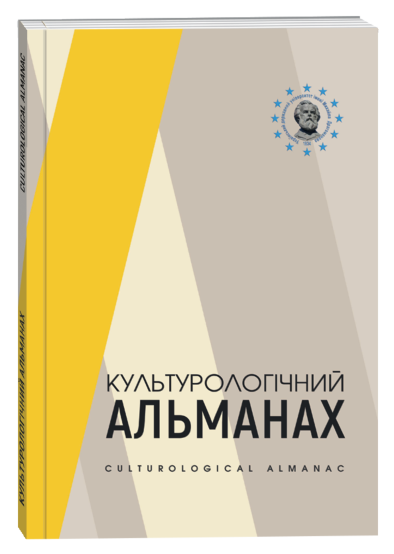THEATRE AND CINEMA IN THE ERA OF ARTIFICIAL INTELLIGENCE: INTERACTIVE MODELS OF GAMIFICATION
DOI:
https://doi.org/10.31392/cult.alm.2025.1.38Keywords:
gamification, interactivity, artificial intelligence, virtual communication, performativity, theatre, stage space, cinema, interactive cinema, video gameAbstract
The article presents a study of the processes of gamification of the stage and screen arts, outlining the role of artificial intelligence in the formation of new interactive models of virtual communication on the examples of films and theatrical performances. The author observes the expansion of cultural and creative practices, which are directed by the creative and intellectual activity of artists towards virtual forms of communicative interaction, characterised by a high level of technological dependence on digital tools, including artificial intelligence. The study of theatrical performances and films reveals the significant role of artificial intelligence and virtual reality technologies, which are actively used to create new interactive models of communication with elements of gamification. The article analyses the methods of gamification based on the use of game elements in non-game and game socio- cultural practices and contexts, highlights their penetration into various spheres of elite and mass culture, which increases the level of communicativeness, participativeness, audience motivation, has performative and hedonistic functions and is entertainment. Experimental theatrical performances and interactive cinema are considered, where the creation of an alternative reality based on the principle of ‘person in the process’ and ‘choose for yourself’ takes place with the active participation of the audience through the construction of non-linear narratives, that resemble a video game. The gamification of theatrical and cinematic cultural spaces promotes audience engagement through the construction of virtual communication mechanisms with the possibility of creative self-expression, socialisation and identification, which is interpreted by the viewer as self-manifestation in an illusory, alternative reality that he or she chooses and creates.
References
Зубавіна, І. (2021). Онтологія віртуального простору: Екранознавчі зшитки / Інститут проблем сучасного мистецтва НАМ України. Одеса: Видавничий дім «Гельветика». 376 с.
Клековкін, О. (2019). Homo Digital: Формула споживання (Малий органон). Науковий журнал Художня культура. Актуальні проблеми, 15(1), 69–77. https://doi.org/10.31500/1992-5514.15(1).2019.169007
Чепелик, О. (2018). XR-технології в мистецтві України. Науковий журнал Художня культура. Актуальні проблеми, (14), 60–71. https://doi.org/10.31500/1992-5514.14.2018.151063
Чміль, Г., Корабльова, Н. (2019). Онтологічна залежність від себе: технології симуляції особистості. Нарація «зображуване-глядач» у сучасному культурному просторі: монографія / Г. П. Чміль, І. Б. Зубавіна та ін. К.: Інститут культурології НАМ України, С. 227–238.
Chibalashvili, A. ., Bezuhla, R. ., Kharchenko, P. ., SEVERYNOVA, M. ., & KORENYUK, Y. (2024). Artistic Practices in the Context of the Evolution from Web 1.0 to Web 3.0. Studia Universitatis Babeș-Bolyai Musica, 69 (Special Issue 2), 103–112. https://doi.org/10.24193/subbmusica.2024.spiss2.08
Ellestrom, Lars (2020). Beyond media borders.: (Intermedial relations among multimodal media). Palgrave Macmil- lan, 267 p. https://doi.org/10.1007/978-3-030-49679-1
Griffin, David (2019). How Netflix's You vs. Wild Is Different from Black Mirror: Bandersnatch. A choose your own adventure story featuring Bear Grylls... 04.05.2019. Retrieved from: https://www.ign.com/articles/2019/04/04/how- netflixs-you-vs-wild-is-different-from-black-mirror-bandersnatch
Helles, R. (2013). Mobile communication and intermediality. Mobile Media & Communication, 1(1), 14–19. https://doi.org/10.1177/2050157912459496
Jensen Beth (2025). AI Brings New Potential to the Art of Theater. Arts and Humanities. Standfort University, Institute for Human-Centered Artificial Intelligence (HAI). URL: https://hai.stanford.edu/news/ai-brings-new-potential-art-theater
Marques, C. G., Pedro, J. P., & Araújo, I. (2023). A Systematic Literature Review of Gamification in/for Cultural Heritage: Leveling up, Going Beyond. Heritage, 6(8), 5935–5951. https://doi.org/10.3390/heritage6080312
Mules, W. (2000). Virtual Culture, Time and Images: Beyond Representation. M/C Journal, 3(2). https://doi.org/10.5204/mcj.1839
Mueller, J. E. (2015). Intermediality in the age of global media networks – including eleven theses on its provoc- ative power for the concepts of “Convergence,” “Transmedia storytelling” and “Actor network theory”. Substance, 44(3), 19–52. Retrieved from: https://www.proquest.com/scholarly-journals/intermediality-age-global-media-networks/ docview/2085803015/se-2
Murphy, Jill (2022). Cinema and Intermediality: The Passion for the In-Between (Second, Enlarged Edition), by Ágnes Pethő. Alphaville, (22), University College Cork, p. 127–132 DOI: https://doi.org/10.33178/alpha.22.14
Paech J., Schröter J. (2008). Intermedialität Analog/Digital: Theorien – Methoden – Analysen. Paderborn: Wilhelm Fink. 618 p. https://doi.org/10.30965/9783846743744
Wu, C.-H., Chao, Y.-L., Xiong, J.-T., & Luh, D.-B. (2023). Gamification of Culture: A Strategy for Cultural Preservation and Local Sustainable Development. Sustainability, 15(1), 650. https://doi.org/10.3390/su15010650








